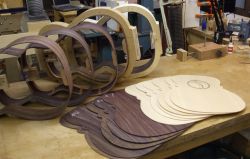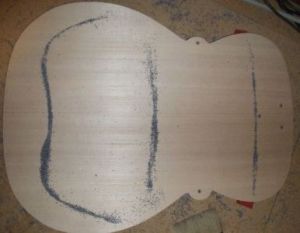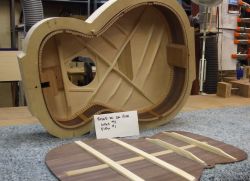Research
This page has not been updated in a while. John has been busy in the shop and there is a never-ending amound of research going on daily in the shop. While this is true, a formal approach to research has taken a back seat to more empirical testing. John has developed a system to dynamically test his wood samples, feeding this information into program to guide him to final thickness.
There is a lot of information out there and much of John's direction in these areas came from Alan Carruth. Al seems to find the time to put together test beds and then find time to write about what he found. In addition, Hurd's book, Left Brain Lutherie along with Trevor Gore's books are great resources in this area.
 |
As noted on the the design page it is not John's intention to try to reinvent the wheel. Still trying to research what has worked in the past certainly can help our understanding of what will work today and tommorow. The research can be simply playing and inspecting instruments, or it can involve measuring (dimensionally and acoustically) components of an instrument. John is not governed by the scientific approach to building, but rather uses this information to help his understanding and intuition while building. Tone is so subjective, that manipulating a parameter because science says we should, may not always result in a better guitar. |
The photo to the right, shows 5 experimental guitars that John has in process. They are all made from Indian Rosewood with Sitka tops. In the Spring of 2008 John ran a left-brain lutherie indepedent study class with 2 engineering students from the local community college. |
 |
 |
John measures the stiffness of all his tops (and backs) using a static deflection technique. He checks both the Modulus of Elasticty, (MOE) along the grain and accross the grain. First John pre-loads the piece and then adds more weight. The deflection is then noted. He flips the piece over and repeats the measurement. Using the carefully collected dimensions and weight measurements, the Modulus of Elasticy can be calculated. This allows for different dimensioned pieces of wood to be compared more closely. |
The Top wood and bracing is an influential design feature that impacts sound. The free plate top and bracing are carefully manipulated while being monitored through combination of tapping, flexing, listening, scratching, and checking with test equipment. |
 |
 |
Chaldni patterns are used to help tune free plates before and during the bracing process. A sine wave is feed into an amplifier to a speaker, and the frequency is monitored. Much of what is learned from the patterns corelates to the tapping of the top, but the glitter (or in this photo, the poppy seeds) give a "picture" of what is going on. John also uses spectrum analysis, to "see" what he is hearing. It is a way to keep visual and numeric records of what is heard. Although it is difficult, to corelate all the data, having "targets" help to focus the tuning process. Luthier Alan Carruth has done lots of research in this area and has been very helpful in the scientific approach to this tuning process. |
To the right, is one of the experiment guitars. This one was made fairly close to "factory" dimensions. It will be the "standard" used in comparison to the other experiment guitars.John plans to continue his research. It is a hard thing though, as "real" experiments are very tough in lutherie and it is difficult to narrow down the variables. Still that is part of the fun and challenge, and is what makes this craft an art form. Hopefully there will be some updates on Reseach from time to time. Please check back (or bug John, to post more info) |
 |